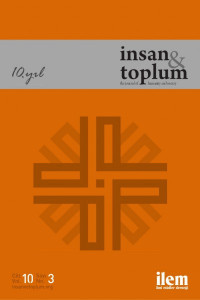Abstract
Sanayi Devrimi’nden günümüze kadar mesleki eğitim, iş piyasalarında ihtiyaç duyulan insan kaynaklarının yetiştirilmesini sağlayarak ülkelerin ekonomik kalkınmalarına çok önemli katkılarda bulunmuştur. Mesleki eğitimin muhtelif ülkelerde ya bir eğitim türü yaklaşımı ya da bir istihdam yaklaşımı ile inşa edildiği görülmektedir. Mesleki eğitimin bir eğitim yaklaşımı ile inşa edildiği ülkelerde, eğitimin iş piyasası ile ilişkileri zayıf ancak yükseköğretim ile ilişkileri güçlü olmaktadır. Diğer taraftan mesleki eğitimin bir istihdam yaklaşımı ile inşa edildiği ülkelerde ise eğitim, iş piyasası ile çok güçlü ilişkiler kurarken yükseköğretimle bağı zayıf kalmaktadır. Bu ikinci grup ülkelerde mesleki eğitimin tüm süreçleri, ilgili sektörlerin tüm yasal temsilcileri ile birlikte yürütülmekte, eğitim ve iş pozisyonları çok açık bir şekilde ilişkilendirilerek standart hâle getirilmektedir. Dolayısıyla bu ülkelerde okuldan işe geçiş kolay olduğu için genç işsizliği de düşmektedir. Ancak günümüzde gelinen noktada her iki yaklaşımın da iş piyasası ve ekonomilerde gerçekleşen dönüşümlere cevap vermekte giderek yetersiz kaldığı görülmektedir. Bu nedenle mevcut çalışmada, mesleki eğitimin yüzleştiği sorunlar ele alınmakta ve ülkelerin ürettikleri çözümlerin ortak özellikleri belirlenmeye çalışılmaktadır. Küresel ölçekte mesleki eğitimde yapılan dönüşümlere bakıldığında, yeni mesleki eğitimin hem eğitim hem de istihdam yaklaşımının güçlü özelliklerini birleştirerek kendisine yönelik dış tehditlere cevap üretebileceği gösterilmektedir. Bu bağlamda ülkeler hem iş piyasası hem de yükseköğretimle ilişkileri güçlü bir mesleki eğitim sistemi kurduklarında mesleki eğitimle ilgili birikmiş sorunların büyük oranda çözülebileceği gösterilmektedir. Ayrıca yeni dönüşümün geleceği, eğitim ve iş piyasası arasındaki entegrasyonu farklı açılardan değerlendiren kuramlar açısından ele alınmakta ve yeni dönüşümün mezunlar ve iş piyasaları açısından oldukça olumlu sonuçlar doğuracağı gösterilmektedir.
References
- Acemoğlu, D. ve Restrepo, P. (2018). Artificial intelligence, automation and work. NBER Working Paper 24196. National Bureau of Economic Research, Cambridge
- Arrow, S. (1968). The transition from school to work. Princeton, NJ: Woodrow Wilson Sch.
- Abusland, T. (2014). Early leaving from vocational education and training: United Kingdom. UK: UK NARIC, ECCTIS.
- Allmendinger, J. (1998). Educational systems and labour market outcomes. European Sociological Review, 5(3), 231-250.
The New Factors Affecting the Schoolto- Work Transition for Vocational Education and Training: New Trends in Global Transformation
Abstract
From the industrial revolution up to now, vocational education and training (VET) has contributed greatly to the countries’ economic development by providing the required human resources to the labor market. VET systems are structured in various countries with either an education approach or an employment approach. In countries that VET is structured with an educational approach, the relations of education with the labor market are weak, but the relations between VET and with higher education are strong. On the other hand, in countries where vocational education is structured with an employment approach, quite strong relations between VET and the labor market are established, while the relations between the VET and higher education are weak. In this second group of countries, all VET processes are conducted together with the legal sector representatives, and education and job positions are clearly standardized and matched. Therefore, youth unemployment is comparatively lower in these countries depending on the easy transition from school-to-work. However, it is seen that both approaches are becoming inadequate to respond to the current transformations in the labor market and economies. In this study, the problems that faced by VET are evaluated, and the common characteristics of the solutions produced by the countries are tried to be determined. When transformations in VET systems on the global scale are reviewed, it is shown that the new VET must combine the strong characteristics of both education and employment approaches, and produce strong answers to external threats. In this context, it is shown that the cumulative problems related to VET can be solved substantially when countries establish VET systems with strong relations with both the labor market and higher education. Lastly, the future of the new transformation in VET is discussed within the scope of theories that evaluate the integration between VET and the labor market with diverse perspectives, and it is shown that the new transformation will provide quite positive outputs in different aspects for graduates and job market.
Keywords
Vocational education and training human capital skills mismatch labor market employment higher education
References
- Acemoğlu, D. ve Restrepo, P. (2018). Artificial intelligence, automation and work. NBER Working Paper 24196. National Bureau of Economic Research, Cambridge
- Arrow, S. (1968). The transition from school to work. Princeton, NJ: Woodrow Wilson Sch.
- Abusland, T. (2014). Early leaving from vocational education and training: United Kingdom. UK: UK NARIC, ECCTIS.
- Allmendinger, J. (1998). Educational systems and labour market outcomes. European Sociological Review, 5(3), 231-250.
Details
| Primary Language | Turkish |
|---|---|
| Subjects | Other Fields of Education |
| Journal Section | Research Articles |
| Authors | |
| Publication Date | September 15, 2020 |
| Published in Issue | Year 2020 Volume: 10 Issue: 3 |


